Doodled while listening to his interview with Adam Buxton.
See it bigger, below.
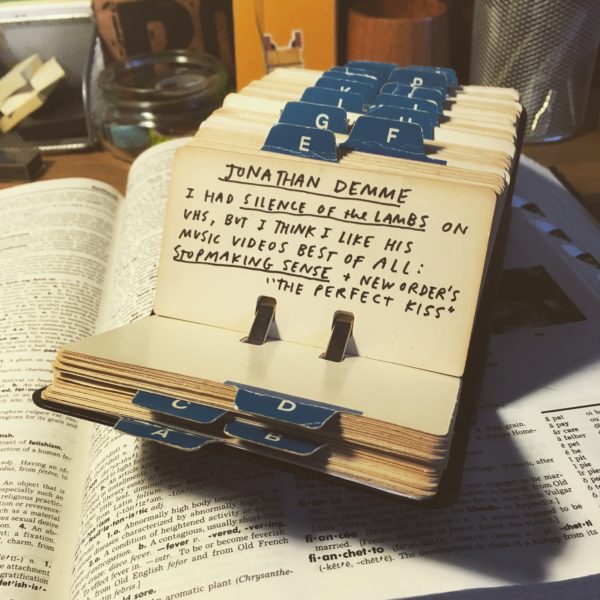
Last year I bought an old Rolodex with the original cards in it for $2 at Goodwill. I wasn’t sure what to do with it, then I came up with the idea of listing my favorite artists and telling my kids about them. I leave it on my desk and whenever I have some extra time, I pull it out and add a few entries.
My Rolodex project: I list artists I like and tell my kids about them pic.twitter.com/eqvbZ5Sldo
— Austin Kleon (@austinkleon) April 27, 2017
Here are some of the cards:

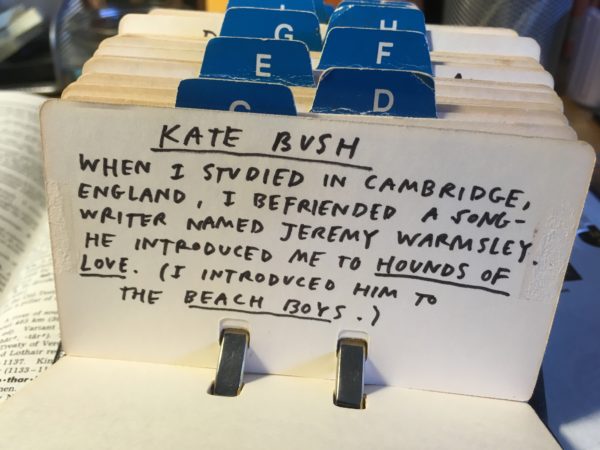
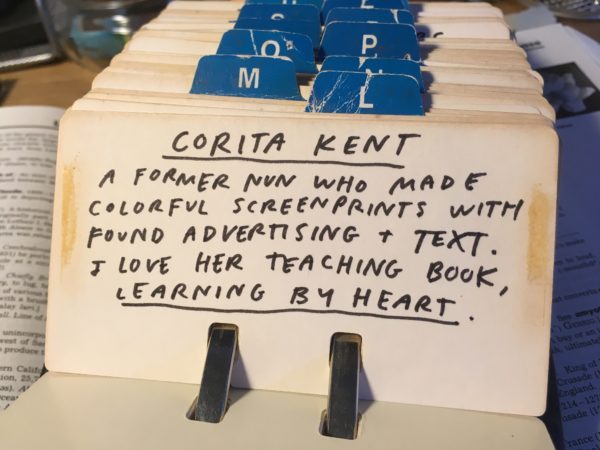
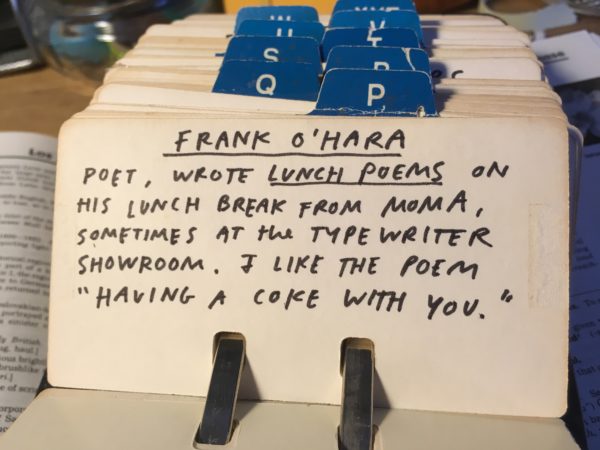
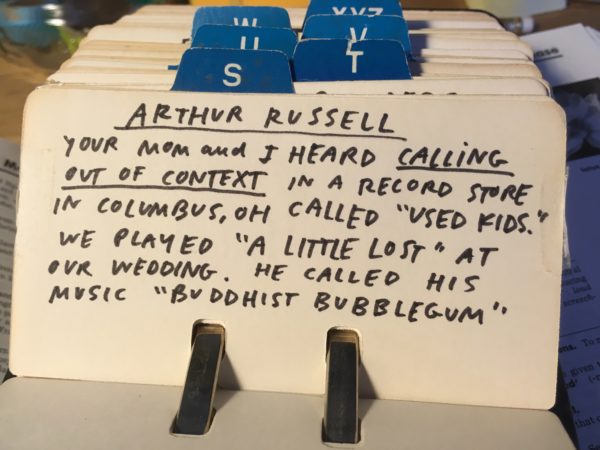


PS. I found out you can still buy new Rolodexes and new cards for them!


“I have not been a good father,” admitted John Banville in a recent interview. “I don’t think any writer is.” He went on to talk about how hard his profession had been on his family, and how hard he imagined it had been to live with him as a husband and father. Of writers, as if we are all one homogenous tribe, he said, “we are cannibals. We’d always sell our children for a phrase…. we are ruthless. We’re not nice people.”
“Speak for yourself, fucknuts,” David Simon tweeted. “Family is family. The job is the job.”
My twitter pal Julian Gough, who brought it all to my attention, summed it up nicely: “When a famous writer says ‘all writers are bad parents,’ he is giving young writers permission to behave like assholes.” (Julian has since published his own piece on the subject.)
My oldest son turned four this week, so I’ve been taking stock, and thinking about how lucky I was early on in my life to find examples of good writers who also seemed to be good dads. (And yes, early on, I was looking for men as role models, even though today I get more inspiration from mothers.)
When I was 24, I asked George Saunders at the Texas Book Festival how he managed to be a good family man and a good writer. I drew his response in my notebook:
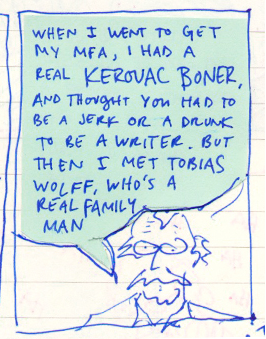
Saunders later wrote about this revelation in “My Writing Education”:
I watch Toby, with his family. He clearly adores them, takes visible pleasure in them, dotes on them. I have always thought great writers had to be dysfunctional and difficult, incapable of truly loving anything, too insane and unpredictable and tortured to cherish anyone, or honor them, or find them beloved.
Wow, I think, huh.
And elsewhere:
“Toby was the first great writer I ever met and what the meeting did for me was disabuse me of the idea that a writer had to be a dysfunctional crazy person… Toby was loving, gentle, funny, kind, wise — yet he was producing these works of great (sometimes dark) genius. It was invigorating to be reminded that great writing was (1) mysterious and (2) not linked, in any reductive, linear way, to the way one lived: wild writing could come from a life that was beautifully under control. Watching him, I felt: O.K., nurture the positive human parts of yourself and hope they get into your work, eventually.”
Tobias Wolff himself talked about the subject in The Paris Review:
The self-pity of being a writer or an artist has been a sovereign excuse for all kinds of baloney. You know, All the sufferings I endure and the terrible things I do to my wife and children are because I’m an artist in this philistine America… I find that all the best things in my life have come about precisely through the things that hold me in place: family, work, routine, everything that contradicts my old idea of the good life…. it seems as time goes on that the deepest good for me as man and writer is to be found in ordinary life. It’s the gravity of daily obligations and habit, the connections you have to your friends and your work, your family, your place— even the compromises that are required of you to get through this life. The compromises don’t diminish us, they humanize us—it’s the people who won’t, or who think they don’t, who end up monsters in this world.
Wendell Berry said something very similar in the documentary Look & See — that art is elevated by interruption, that it gains meaning from interruption.
And interruption is the very true constant of the parent’s life, as this Tillie Olsen epigraph from Sarah Ruhl’s great book on parenting and writing explains:

For those of us who have or are thinking about having kids, it’s so very important to find solid role models we can look to — people who have managed to raise children and make their art. I’m not the greatest dad, but any success I’ve had in the past four years as a parent is due to the good examples I found before I became one.
It’s also important for us to be role models: to show that it can be done.
I’ll give the last word to JG Ballard, who raised his three children as a single widower:
Cyril Connolly, the 50s critic and writer, said that the greatest enemy of creativity is the pram in the hall, but I think that was completely wrong. It was the enemy of a certain kind of dilettante life that he aspired to, the man of letters, but for the real novelist the pram in the hall is the greatest ally – it brings you up sharp and you realise what reality is all about. My children were a huge inspiration for me. Watching three young minds creating their separate worlds was a very enriching experience.
Art is for life, not the other way around.
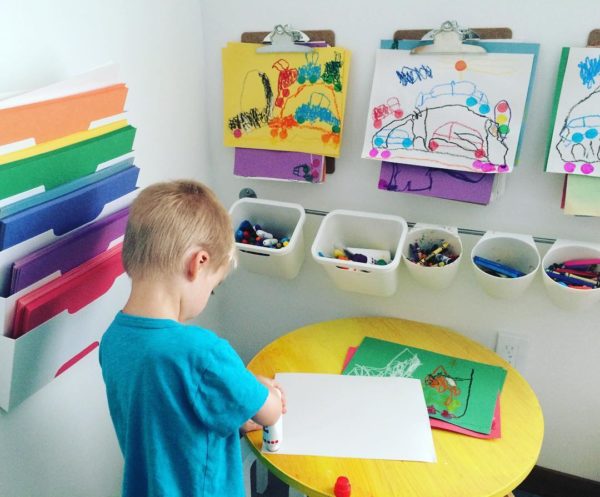
I came in from my 10-foot commute once and my 3-year-old looked up from his snack and said, “What did you make today, papa?”
It took me by surprise, as I had always assumed that when I was out of sight I was out of mind. (I now know that children seem to be most interested in you when you’re not around. When you’re actually around, they love to ignore you.) “No, he asks about you all the time,” my wife said. “He always wants to know what you’re doing. I tell him, ‘Papa’s out in his studio making things.’”
I can’t remember if that day I’d actually made anything. Some days I don’t, you know. Some days, the sad, pathetic days, it’s just answering e-mail and thinking about all the things I should be making and how I’m not making them.
But rarely does a day go by when my son doesn’t make something. I envy his setup and his habits. His mom has placed all the supplies within easy reach. He doesn’t torture himself. The goal is simple: There is a car-carrier truck that doesn’t exist that needs to exist. He sets to work with clear purpose and utter concentration. There is frustration, occasionally, but it usually passes. And when he’s done, he’s done, and it’s off to something else.
I try my best to copy the approach. First, I try to be my own mother: leave the workspace tidy, pens and notebooks at hand. Then, I try to be him: I try to go at it with his intensity, but also his indifference to the results. I fail more often than not.
“I learned so much about art from watching a kid draw,” said John Baldessari, former grade-school teacher. “Kids don’t call it art when they’re throwing things around, drawing—they’re just doing stuff.”
Almost every parenting cliché I’ve ever heard has turned out to be true. This makes it hard to add anything original. (Originality is yet another thing my son has never worried about.) Kay Ryan says a poet’s job is to rehabilitate clichés, but I sure don’t envy those who write parenting memoirs. All I feel I can offer is corroboration of the cliché: Sunday will be my fourth father’s day and I’m still learning and I still feel like he’s teaching me more than I’m teaching him. He’s asking me all the questions I should be asking myself.
“What did you make today, papa?”
This site participates in the Amazon Affiliates program, the proceeds of which keep it free for anyone to read.